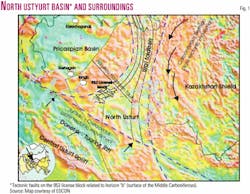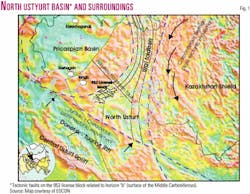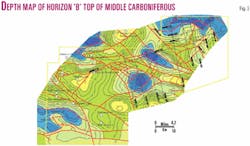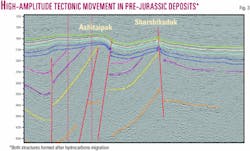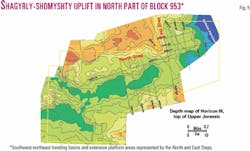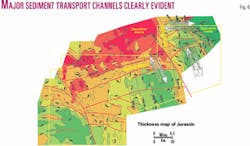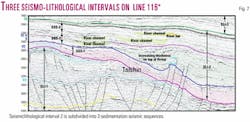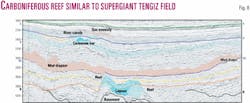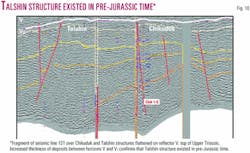New seismic better defines North Ustyurt basin potential
The North Ustyurt basin occupies the area adjacent to the southeastern part of the Pre-Caspian basin. Its tectonic activity was initiated by counterclockwise movement of the Kazakhstan shield during Carboniferous and Permian time and compression from the northeast caused by the collision with the Central Karakums tectonic subcontinent in Jurassic and Cretaceous time (Fig.1).
Soviet geologists have extensively explored the North Ustyurt basin since the mid-1960s. Several thousand kilometers of 2D seismic data were acquired, most of which were of very low quality. About 15 delineated structures were drilled by deep exploration wells. Ultimately, only four of those structures, Karakuduk, Komsomol, Kultuk, and Arstanov, have commercial oil reserves, and one structure, Begesh, has noncommercial reserves due to low porosity of the Lower Jurassic sediments.
Three gas fields with reserves up to 1 tcf are found in Eocene deposits of the North Ustyurt basin. Some scientists believe this gas migrated from deeper sediments.1 Five gas fields are known in the Jurassic of the Uzbekistan part of North Ustyurt. All these results indicate that Jurassic sediments are most likely to contain hydrocarbons.
However, data from the drilling of all these structures led to the conclusion that marine deposits from Upper Devonian to Middle Carboniferous and Lower Permian (Artinskian) are the major source rocks for the North Ustyurt area. Another source rock is the Upper Triassic and Lower Jurassic alluvial and lacustrine sequence.
Recent exploration
In 1998, American International Petroleum Kazakhstan became the operator of a license block covering most of the North Ustyurt area (Fig.1) and acquired 950 km of high-quality 2D data. Analyses of this seismic data showed that there are several stages of tectonic activity with two imparting the most influence on structural development.
The first stage of major tectonic activity occurred in Upper Triassic-Lower Jurassic time and is characterized by significant, up to 1,500 m, of vertical movement. This stage can be easily seen on the structure map of horizon "b" (Fig. 2), which represents the Middle Carboniferous surface. The direction of these tectonic movements agrees with the orientation of the major plate tectonic movements described above.
The second stage of tectonic activity, dated as Late Cretaceous, played a key role in forming numerous structures in the western part of the block.
Two types of structures have been drilled in the license block.
The first type is widely represented by structures in the western and northwestern parts of the block, many of which, such as Ashitaipak and Sharshikuduk, have been drilled (Fig. 3). This type of structure formed above large-offset faults in pre-Jurassic sediments. Vertical offset of these faults may be as much as 1,000 m.
Analysis of deposition history shows that tectonic activity resumed in Cretaceous time, and these structures formed after the migration of Jurassic hydrocarbons was completed. It is highly unlikely that any hydrocarbons will be found in the pre-Jurassic and Jurassic of these structures.
Begesh structure
The second type of drilled structures is represented by the Begesh structure (Fig. 4), which formed during the Upper Triassic stage of tectonic activity. Analysis of sedimentation shows that this type of structure formed during an early stage of tectonic activity in Permian-Upper Jurassic time. Later stages of tectonic movement in these structures were of low intensity and probably did not damage the integrity of seals over the hydrocarbon deposits.
Exploration work done by AIPK on the Begesh structure, along with results of earlier Soviet exploration, identifies hydrocarbon deposits in the Lower Jurassic. However, porosity and permeability of the oil-saturated sands is very low, not more than 12% open porosity at a depth of 3,880 m, which is not an economically viable project.
Tests of the Middle and Upper Jurassic in the Begesh structure showed that it contains high-porosity water-saturated reservoirs. The lack of hydrocarbons can be explained by the small volume of hydrocarbon-generating source rocks in the proximal part of the basin.
Analysis of the structure map on the top of the Upper Jurassic (Fig. 5), the isopach map of Jurassic sediments (Fig. 6), and the base of the Jurassic allows the exploration area to be subdivided into several structural-tectonic elements.
Structural elements
Basic structural elements are the Mynsualmas high in the north, a system of troughs oriented southwest-northeast in the central part, a relatively deep, approximately east-west trending step–the Northern Step, and a roughly north-south trending step–the Eastern Step. These steps are clearly delineated by tight flexures on the Upper Jurassic structure map.
The contour pattern in the central part of the Northern Step represents a nose with depths decreasing northward. Similar noses of decreasing depths are clearly seen within the Eastern Step on the top of Jurassic structure map. Increased thickness (bulges) of the Jurassic on the isopach map coincides with zones described above. This leads us to speculate that there were pathways (channels) of intensive sediment movement along large-scale river systems.
Structural features of the steps, directions of a sediment movement within the steps, proximity to sediment sources and depocenters are indirect indicators of the high potential for the existence of a wide range of sedimentary targets within which nonanticline hydrocarbon traps could be formed.2
There are three structural-lithologic intervals (SLI) bounded by unconformity surfaces that can be distinguished on seismic lines. The top of SLI-1, the deepest, is an erosional surface and represents the top of the tectonically uplifted Triassic. In the middle, SLI-2 is bounded at the top by a regional Upper Jurassic carbonate. The shallowest, SLI-3 includes Cretaceous and Paleogene sediments.
Several unconformity surfaces can be distinguished on seismic sections within SLI-2, subdividing it into three seismic sedimentation sequences (SSS).2
The first (lower) SSS-1 is close to the Late Triassic–Early Jurassic. On seismic sections the SSS-1 surface is distinguished by the interruption of reflections above and below the coherent reflectors in a typical pattern of overlapping and adjoining horizons.
About 3 or 4 seismic facies are distinguished within the sequence, forming a lateral sequence of relatively large, lens-like sedimentary targets of various ages, which in a number of cases are controlled laterally by elevated blocks in the deeper SLI-1.
Within the sequence massive wedge-type bodies are evident, which form regular lateral rows (lines 118-127, 116, 105) that are interpreted as major deltaic cones. Their location on the map coincides with the noses on the top of Upper Jurassic structure map and on the isopach map of the Jurassic as described above.
The internal structure of the sediments, their thickness, and wide lateral extent testify to the presence of a large source and high-energy transportation paths for the sediments (Fig. 6). The formation of this sequence took place during a period of rather insignificant tectonic activity.
The presence of massive wedges of foredelta deposition cones oriented toward the depocenters of large basins is clear evidence for the presence of starved basins where sediments with high organic content were accumulated over a long period of time.2 On the boundary between SSS-1 and the overlying SSS-2 sudden high tectonic activity accompanied by upward movements of the blocks occurred in the area.
On the elevated blocks of SSS-1 sediments were partially eroded. SSS-2 and SSS-3 cover SSS-1 and have regional extent.
On seismic sections the internal structure of SSS-2 is expressed by subparallel reflections. The thickness of SSS-2 on time sections is 0.2-0.3 sec. Seismic facies having the shape of lenses can be identified within this sequence (Fig. 7). These facies are interpreted as paleo-rivers with an apparent thickness of 0.012-0.015 sec on the seismic sections. The age of this sequence is Middle Jurassic.
The thickness of SSS-3 is insignificant. The seismic character of the lower part of SSS-3 section is "transparent" in nature and represented by a good quality shale seal. The upper part of this sequence is represented by a strong reflector that persists across the entire exploration area and corresponds to the top of the Upper Jurassic carbonates.
Promising conditions
Seismic stratigraphy indicates a number of sedimentary conditions that are promising for oil and gas exploration. A relatively deep marine basin existed within the exploration block during Upper Triassic and Lower Jurassic time with maximum depths in the northeastern part of the area.
Sediment-starved lows were located within the deepest parts of the basin, where clays, enriched with organic matter, were deposited. Foredelta deposition cones, representing massive wedge-type sedimentary bodies that formed in regression-transgression cycles of relative sea level change, filled the basin. Tectonic activity increased again between Early and Middle Jurassic time, and vertical movements took place within the elevated blocks. Uplifted Lower Jurassic sediments were partially eroded at this time.
At the beginning of the Middle Jurassic, energy in the source area decreased, and the area became a coastal plain with a relatively well-developed system of rivers. During the Middle Jurassic major rivers, lakes, and smaller deltaic cones may have existed. Because tectonic movements often controlled large river channels, the probability for traps in fluvial sediments is high.
In the Late Jurassic, accumulation of sediments took place in rather quiet conditions. Because the source areas were already eroded, it is possible to assume that there was an increase in clay content in the sediments. This interval is "transparent" on seismic sections. There was a relative increase of sea level during this period, and very late in the Late Jurassic carbonates were deposited.
Interesting features
Seismic-stratigraphic analysis of the Northern Step identifies several interesting features. Horizon "b" in this area was identified as the top of Middle Carboniferous, which delineated the base of several petroliferous reefs (Saztyube, Tolkyn, Tynyshtyk) located close to northwest corner of the block, and known as horizon P1 in giant Tengiz field.
The quality of seismic data acquired by AIPK is good enough to delineate a reef structure (Fig. 8) analogue of Tengiz, where the Upper Carboniferous reef structure is above of horizon "b" and a Lower Carboniferous reef structure is below the "b" horizon.
Another interesting feature is the similarity of the tectonic setting of this area and salt tectonics of the Pre-Caspian depression. An explanation for this is the high shale content of the Permian sediments that behave like plastic material and represent an exceptional seal for Carboniferous source rocks. This shale seal extends widely across the central and eastern parts of the license block but is not seen on seismic lines in the western part of the block. There are also several river channels identified in SSS-2 within the Northern Step.
The Eastern Step has similar river channels in the same formations and contains a very promising structure in the Lower Jurassic and Upper Triassic. Only one structure has been drilled within the eastern part of the block. Well No. 1 on the Chikuduk structure (Fig. 9) reached a depth of 4,137 m entering the Triassic.
Tests of the Triassic and Jurassic in the Chikuduk structure conducted in 1984 demonstrated the presence of gas with significant formation pressure in the Upper Jurassic.
Talshin structure
As a result of the interpretation of 1998 data using seismic-stratigraphic analysis, a new structure, called Talshin, was identified within the Eastern Step. This structure has a significant thickness of Lower Jurassic and Upper Triassic, whereas on the Chikuduk structure these formations were affected by tectonic movements and were completely eroded.
It is evident from analysis of the depositional history of the Talshin structure, and flattening of reflector V1 (top of Upper Triassic), that it was at least at the same elevation as the Chikuduk structure or possibly even higher during Lower Jurassic time (Fig. 10). This also can be confirmed by the tilted surface of the depocenter northwest of the structure and by the character of the fault on Chikuduk structure.
The map of the Talshin structure (Fig. 11) demonstrates that there are at least three significant advantages to this structure as compared with any other structure within the block:
1.This structure is located right on the edge of the deepest part (up to 7,000 m) of the paleobasin.
2.The character of contours in the shape of a nose pointing toward the center of the paleobasin and, consequently.
3.The structure is located on the pathway of hydrocarbons migrating from the deepest parts of the paleo- basin.
The above points lead to the conclusion that despite the fact that the AIPK license block is in an early stage of exploration it has high potential for discoveries of hydrocarbon deposits.
The central and eastern portions of the block have higher exploration potential, and it is expected that reservoirs there are gas saturated. At least three areas require detailed seismic acquisition in order to delineate targets for exploration drilling.
Acknowledgments
Author is grateful for the assistance and valuable advice from George Pavloff, Dr. Serge Usenko, Alex Marshall, and Anatole Sapozhnikov during preparation of this article. Seismic data presented here are courtesy of AIPK President Jim Knight.
References
1. Bykadorov, V.A., and Fedorenko, O.A., "Proposals for further exploration work on AIPK block and adjoining areas within Northern Ustyurt region," May 2001, Almaty.
2. Usenko, S., "Seismic-stratigraphic evaluation of the exploration potential of the AIPK license block," June 2001, Almaty.
The author
Serge V. Galley ([email protected]) is a petroleum geophysicist/petrophysicist with 20 years of exploration experience. During the 1990s, he worked with Western Geophysical acquiring North Caspian Sea seismic data for six major oil companies and for American International Petroleum Corp., Houston, as operations manager on two Kazakhstan projects. He has a BSc (Hons.) in petrophysics from Karaganda Polytechnic Institute, Kazakhstan, and did postgraduate study at Moscow Oil & Gas University. He also received a PhD at "Soyuzpromgeophysica" Institute at Tver, Russia.
